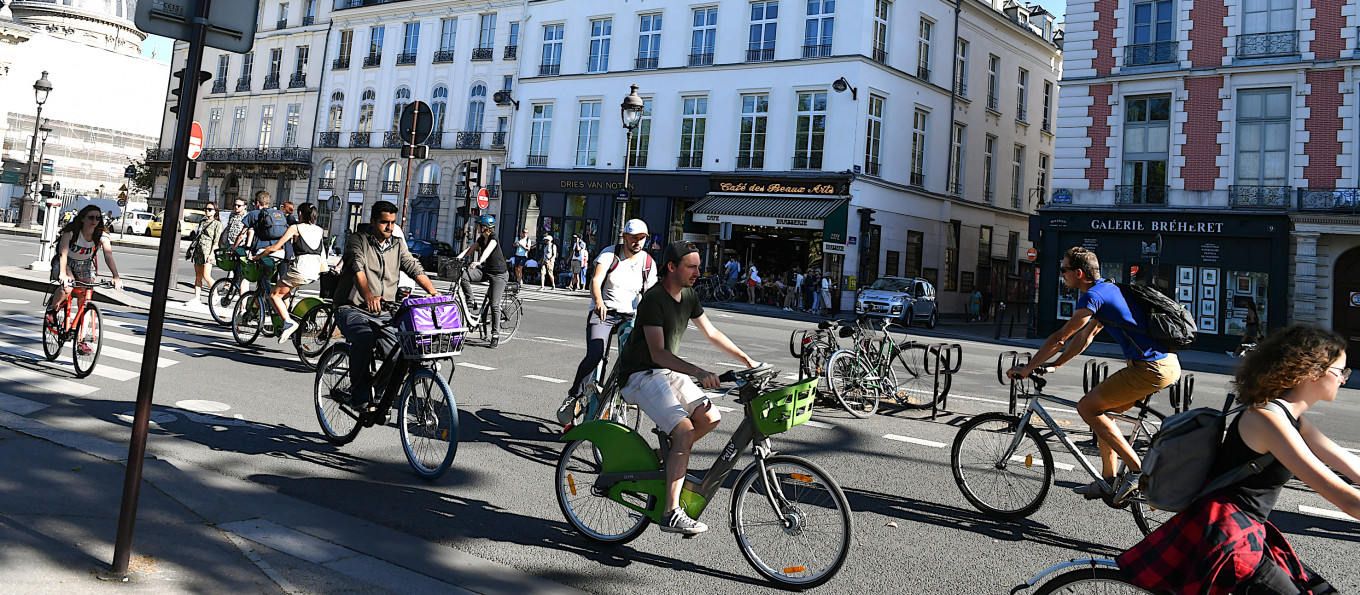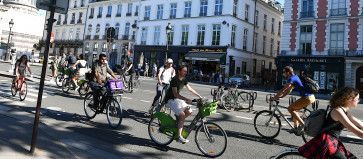Popular Reads
Top Results
Can't find what you're looking for?
View all search resultsPopular Reads
Top Results
Can't find what you're looking for?
View all search results
- -
- Fri, October 6, 2023
Change text size
Gift Premium Articles
to Anyone
Work It Right is a weekly column that provides practical and insightful advice on the complexities of urban transportation.
It was summer in Paris when I visited the notorious city of love. I was there to romanticize the cycling experience in the famous bicycle lanes built during the pandemic.
Before we met Jeremy, a local cyclist who has been commuting 10 kilometers for 10 years by bicycle daily for work and was willing to be our guide, we peddled around the city using a bike-sharing system available all across the city, from privately owned to city-owned (subsidized). We counted around five bike-sharing operators, each with a different payment method.
For those unfamiliar with the bike-sharing concept, bike-sharing is a program that distributes and organizes fleets of publicly shared bikes throughout a city or region for users to rent for transportation or recreation. Users can access bikes across each system’s designated service area through single-use fees or membership plans.
The city-owned system requires an ID and a large deposit. We had to sign up for an account through a machine. At the same time, with privately owned bike-sharing, the user can access or unlock the bicycle via an app, and you just need a local or international phone number to register, which is more tourist-friendly. Later, we discovered that the city-owned operator has more subscribers than the privately-owned one because the locals can use it for everyday use, with six to nine-month subscriptions, and the bikes can be parked anywhere, even at the user’s house.
The city-owned bike-sharing is usually used by commuters to replace the first and last-mile trip to and from the metro or city bus, and we also learned most locals use it as a food delivery mode of transportation. Most of the bicycles in the bike-sharing system are pedal-assist electric bikes that provide a battery-powered boost to riders as they pedal, making it perfect for delivery with heavy luggage, longer distances or hilly trips.
The tweets and articles we read during the pandemic on how Paris is transforming into a cycling city got approval from Jeremy. He stated that for decades, the grassroots community often held strikes and organized movements demanding better cycling infrastructure, “it was quite ironic because [geographically] we are not that far away from the Netherlands, the cycling-friendly country”, he said. One of the communities created a Vélopolitain movement inspired by Paris's efficient metro system, hoping for a structural, continuous and high-capacity network of secured bike lanes.
The transformation of Paris into one of the world's biggest bicycle-friendly cities is relatively fast. The COVID-19 crisis of the previous two years has underscored the need for healthier, more active modes of mobility alongside accessible public spaces designed for all types of communities. Paris then adopted a citywide cycling plan that capitalized on the surge in cycling that arose during the pandemic. Plan Vélo 2021-2026 targeted turning “pop-up” bicycle lanes created during the pandemic into permanent infrastructure while adding over 130 km of protected lanes to the city’s existing Vélopolitain network.
The first phase of the expansion is already well-received, with a reported 60 percent increase in people utilizing bike lanes since before the pandemic. To support this transformation, Paris has also been redesigning its streets to better accommodate pedestrians and cyclists alike — by 2026, the city plans to reclaim one out of every two on-street parking spaces for new trees, playgrounds and bike and shared mobility facilities. The city has committed 250 million euros (US$290 million) to “Plan Vélo” to build a safer, fully cyclable city in the next few years. “I go home with my bicycle, passing through a temporary protected bicycle lane, and going to work the next day see the protection of the lane is already permanent”, Jeremy described the transformation.
The summer in Paris means the sun rises a little bit longer.
At 7 p.m., the roads were still bright, so we decided to continue our talks about the bicycle scene in Paris by cycling. Jeremy brought his bike, which he usually used for commuting, and took us to several spots. One memorable moment was when our group approached the Eiffel Tower area. Then Jeremy took a road that only locals knew and stopped his bike in front of an enormous tunnel that consisted of two notorious tunnels: Tunnel de la Concorde and Tunnel des Tuileries. The tunnel was initially a road tunnel until 2022, when it transformed into a bicycle route around 966 meters long. Tunnel de la Concorde connects the Champs-Élysées-Tuileries Garden-Louvre museum for 1.7 km. Tunnel des Tuileries is famous for its street art and mural by the local street artists. This tunnel opened in 1967, runs along the Seine River’s right bank and was initially used by motorists. Since 2016, it has been reserved for active mobility, such as pedestrians, bikes, skateboards, rollerblades or scooters. In 2019, this transformation continued with the closure of the Tunnel de la Concorde to motorized vehicles.
It was quite a scary yet fascinating experience for me to ride the bicycle in the tunnel at almost midnight and cross paths with the Parisians back from their office to their home on the bike. Along the tunnel, there was graffiti from local artists on the wall, and some artists were there in several spots to get ready to continue drawing along the tunnel wall. At the end of the tunnel, we rode our bicycles on a pedestrian and bicycle-only road along the river. We concluded our trip by returning to our Airbnb apartment, where we said adieu to Jeremy. The app recorded our trip that day: a 25 km ride by bicycle in Paris.
-- Have a question about urban transportation? Send it to wir@thejakartapost.com with your name and current location (anonymous submissions will also be considered). Please note that The Jakarta Post reserves the right to edit your letters for publication.
The writer is a senior communications and partnership manager at the Institute for Transportation and
Have a question about urban transportation? Send it to wir@thejakartapost.com with your name and current location (anonymous submissions will also be considered). Please note that The Jakarta Post reserves the right to edit your letters for publication.









